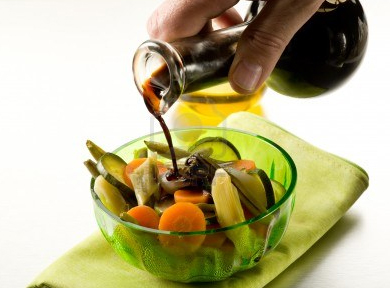| |
|
| All about balsamic vinager |
| |
 |
| |
The production of balsamic vinegar resembles that of wine making. The grapes, traditionally Trebbiano, although other grapes are also permitted, are picked at the peak of ripeness. If the sugar level in the grapes is low, they are placed in wooden open boxes and left in the sun for further ripening.
Then the grapes are crushed and pressed either in a mechanical or manual way. The result of this process, the grape juice, is called the mosto.
In the next 24 hours, the mosto is placed in open steel pots, over direct flame and cooked
at low temperature for 24 to 30 hours. During this process the mosto is reduced in volume by one half. The cooked mosto is then cooled and transferred to holding tanks for fermentation and then to wooden barrels called "vaselli".
Wooden barrels are essential to balsamic vinegar's flavor.
They are built in a variety of woods in decreasing volumes from about 100 to 10 litres, called "batteria". The barrels are stored in vinegar attics to ferment and are exposed to wide fluctuations in temperature, torrid summers and frigid winters. These temperatures are necessary in the process of obtaining an authentic balsamic vinegar.
Usually three barrels, though more can also be used, are necessary for the mosto to undergo the processes that give balsamic vinegar its character.
The first barrel is the largest one. Here the cooked mosto is transferred and the acetic fermentation occurs. During the first year 15 to 30 percent of the volume is lost because of evaporation.
Every year each barrel is topped off from the next larger one and the largest is replenished with new cooked mosto. Over the years the vinegar is transferred to smaller barrels. The vinegar grows denser as it ages. By law, vinegar requires a minimum of 12 years of aging before being approved and sold as a traditional Balsamic Vinegar. Each step in the process, from the concentration and pressing of the grape to the fermentation and oxidation, the constant evaporation and the 12 years of aging in wooden barrels contributes to obtain a high quality Balsamic Vinegar.
Of course, after 12 years, when the vinegar is ready to be bottled and sold, only a fraction of the original volume remains. Only 30 gallons of balsamic vinegar are obtained from the original 800 gallons of grapes. This explains the cost of the vinegar. Actually many of the vinegars sold commercially are imitations, though nowadays cooks and consumers are more aware of the imitations and are looking for the authentic Balsamic Vinegar. |
|
|
| |
|
|